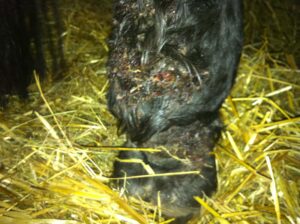The answer can easily be a big yes. All horses can get muck at any time of the year. However, most major infestations of the mealy bug are seen in the autumn and winter months. This is of course largely due to horses staying in damp areas or in direct mud.
Itch is a term for an infection that occurs because the skin is broken and bacteria can enter and cause the infection. Especially the cod joint and the lower part of the legs are exposed. Of course, because this is where the contact with soil and moisture is greatest, but also because the skin is particularly thin here. The moustache helps protect against damage, which is why we never recommend cutting it off. Only if a veterinarian considers it necessary in order to carry out a thorough examination and make a correct diagnosis.
It is therefore a collective term for infection of the lower legs, caused by bacteria, fungi, mites or dermatophilus congolensis, a bacterium that can unfortunately be transmitted from horse to horse.
Protect your horse from muck
Prevention is the key to avoiding the muck. Proper and healthy feeding helps to give the horse a strong immune system. But you can also protect your horse’s skin from the outside with various means. If the skin is intact, bacteria will not be able to invade the horse’s skin and cause wounds.
Shireoil.dk has a wide range so you can choose the right product for your horse. We recommend link to product for horses with hoof beard, and creams link to
product for horses
with no or very little moustache. Whatever the product, it will leave a film on the skin and protect it. If the skin does get damaged, it contains ingredients that are antibacterial and help the wound heal faster.
Muk in code joint:
This is not an uncommon sight, but can easily be healed and prevented from occurring again. Here Farriers Mud Fever Creme would be preferable.
Here you can see a larger infestation of mealybugs:

Here you can see the result of a mould that has been left untreated for a long time.
A veterinarian should be consulted as medical treatment may be necessary. But a barrier of cream will be able to protect the skin while it heals. Here too, Farrier’s Mud Fever cream is recommended.
Both horses should be prevented with Leg Oil Mix, which is mineral oil with sulphur. Also known as Pigoil Sulphur. If the horse cannot avoid wet or muddy folds, Leg Oil Paste is the right choice. In addition to oil and sulphur, it contains a thickening agent that makes it stick to the legs, even under extreme conditions.

